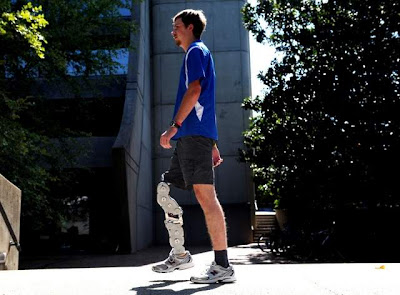"Personalized Service, Care and Education is the cornerstone of our practice"
Friday, August 19, 2011
Monday, August 15, 2011
Shark bite victim becomes pioneer to serve amputees

Craig Hutto’s leg was mangled by a 6-foot-long bull shark with a stubborn streak.
Not long before the attack, he’d heard about a Louisiana girl who died from a shark attack just 100 miles away from Cape San Blas, Fla., where Hutto, then 16, and his family were vacationing. But he just wanted to go fishing, so he was standing in murky water when he felt the first bump, then the agonizing bite. The shark seemed impervious as Hutto’s brother pounded away at its nose with a rod and reel.
Hours later, Hutto lay in a Panama City hospital bed, pleading that his mangled right leg be saved. No leg meant no varsity basketball. No spring baseball. No independence.
But doctors ultimately ruled in favor of life over his lifeless limb, amputating five inches above the knee.
Six years later, Hutto’s life is different from the one he planned. But he feels closer to his family. He’s a few months shy of his bachelor’s degree in nursing from Middle Tennessee State University — a path he never would have taken without that shark’s intervention. And he’s serving as test pilot for a robotic leg being developed at Vanderbilt University, his effort to make life better for the nation’s rising number of amputees.
“I was planning on doing computer science when I went to college,” he said. “Then this happened to me, and I realized these people saved my life and I have to do something to pay them back.”
As a lab assistant at Vanderbilt, Hutto, now 23, works with professor of mechanical engineering Michael Goldfarb and his team of researchers. The leg he’s testing is the first of its kind. It makes it easier for Hutto to walk up slopes and stairs because a computer chip activates an electronic calf muscle.
The leg also makes it easier for Hutto to stay standing because it responds to sudden shifts in motion the way non-mechanized prostheses don’t.
“When it goes on the market, I can tell myself I experienced the falls and mishaps to get it where it is today,” he said.
The robotic leg weighs about 9 pounds and features programmable software that responds to Hutto’s movement. It can tell when he’s trying to sit or stand, or when he needs extra help to walk up stairs. He has been testing the leg for four years, weighs in on the leg’s functionality and gives researchers feedback on any issues that may arise.
Hutto also reviews other studies and literature about prostheses for the team.
Continue story click here
Monday, August 1, 2011
Elephant With Prosthetic Foot In Cambodia (VIDEO)
From Wildlife Alliance:
PHNOM TAMAO - In 2007, orphaned baby elephant Chhouk was found wandering alone in the forests of Mondulkiri Province, Cambodia. Badly emaciated and separated from his mother, this endangered Asian elephant had lost his left front foot due to injuries sustained from a poacher’s snare. The infection and severity of the illness represented certain death for a young elephant alone in the forest.
The Cambodian government requested the assistance of Wildlife Alliance and wildlife rescue and care director Nick Marx, who made the arduous journey and stayed alongside Chhouk for more than a week while his immediate injuries were tended to. When Chhouk had been stabilized, the injured elephant was transported by truck to Phnom Tamao Wildlife Rescue Center in a difficult and treacherous 26-hour journey. [Text continues below video.]
Chhouk was severely malnourished, his stump was badly infected, and nearly 5 inches of infected tissue and bone had to be removed. After his immediate survival was secure, his long-term care was the next concern. Without a foot, he was suffering severe balance issues, and the strain on his hips and back would make his lifelong welfare unlikely. With funding assistance from SeaWorld & Busch Gardens Conservation Fund, and technical support from the Cambodian School of Prosthetics and Orthotics, Chhouk was fitted with his first prosthetic foot in 2009. Because of his injuries, Chhouk will never be a candidate for release into the forest, but he is immensely beloved both inside Cambodia, and as a global ambassador for Cambodia’s threatened Asian elephant populations. Featured on television in Australia, the U.S., and Britain, he is an eloquent messenger to the world about the need to save Asia’s wildlife and forests.
Elephants are rough on hardware, and each year until he matures, Chhouk will need a replacement foot. As he continues to grow into his adolescence, he requires new prostheses to fit his growing frame and replace those lost to wear and tear. This month, Wildlife Alliance and the Cambodian School of Prosthetics and Orthotics fitted Chhouk with his fourth prosthesis.
You can visit Chhouk at Phnom Tamao Wildlife Refuge Center, an hour outside of Phnom Penh, Cambodia to meet him and learn more about his inspiring story. If Cambodia is too far away, check out this video of the inspirational elephant, taking his new foot out for a walk in the forest and a swim in his lake.
Visit www.wildlifealliance.org to learn more.
Subscribe to:
Posts (Atom)